|
|
Obelisks in the Egyptian Museum (9 objecets)
| Present Site: | Tahrir Square, Cairo, Egypt N 30°02'50.2"(30.047272) E 31°14'01.1"(31.233638) |
| 1. | Pharaoh: | Queen Hatshepsut (The 18th Dynasty, 15 Century BC) |
| Portion & Size: | Pyramidion, 2.75 meters high | |
| 2. | Pharaoh: | Ramses II (The 19th Dynasty, 13 Century BC) |
| Portion & Size: | Upper portion, About 2.6 meters high | |
| 3. | Pharaoh: | Ramses II (The 19th Dynasty, 13 Century BC) |
| Portion & Size: | Upper portion, About 1.7 meters high | |
| 4. | Pharaoh: | Ramses II (The 19th Dynasty, 13 Century BC) |
| Portion & Size: | Upper portion, 2.73 meters high | |
| 5. | Pharaoh: | Ramses IV (The 19th Dynasty, 12 Century BC) |
| Portion & Size: | Upper portion, 1.56 meters high | |
| 6. | Pharaoh: | Tuthmosis III (The 18th Dynasty, 15 Century BC) |
| Portion & Size: | Fragment, About 3.7 meters high | |
| 7. | Pharaoh: | Unknown, possibly late period dynasty or Ptolemaic dynasty |
| Portion & Size: | Fragment, About 1.5 meters high | |
| 8. | Pharaoh: | Nectanebo II (The 30th Dynasty, 4 Century BC) |
| Portion & Size: | Lower portion, About 1.8 meters high | |
| 9. | Pharaoh: | Ahmose II (Amasis) (The 26th Dynasty, 6 Century BC) |
| Portion & Size: | Lower portion, About 1.3 meters high |
About The Site:
This is a famous Egyptian Museum, or The Museum of Egyptian Antiquities, in Cairo. There are nine (9) obelisks including its fragments, in this museum. Seven (7) are placed in the garden of this museum, and two (2) are displayed indoor. No restoration work was done, and they are just placed in the garden without any explanation.
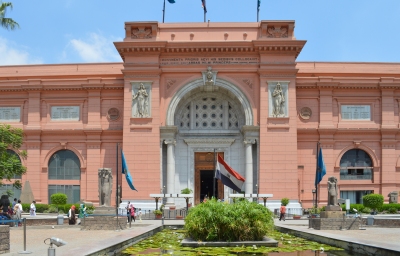 Now, the new museum building, The Grand Egyptian Museum (GEM) is planned, and is currently under construction in Giza district and is scheduled to be partially open in 2018. The new museum is far about 2 kilometers from the Giza Pyramids. After completion, about 100,000 obejcets will be transferred from the current museum. Since it is less than half even if saying 100,000 objects, it can not be predicted what kind of exhibition will be done after the GEM opened. There is also the possibility that the relocation of the Museum may delay due to the recent political turmoil after the revolution. However the relocation would be done someday.
Now, the new museum building, The Grand Egyptian Museum (GEM) is planned, and is currently under construction in Giza district and is scheduled to be partially open in 2018. The new museum is far about 2 kilometers from the Giza Pyramids. After completion, about 100,000 obejcets will be transferred from the current museum. Since it is less than half even if saying 100,000 objects, it can not be predicted what kind of exhibition will be done after the GEM opened. There is also the possibility that the relocation of the Museum may delay due to the recent political turmoil after the revolution. However the relocation would be done someday.
It is better to visit the current museum before the carrying-out to the GEM begins, as it is possible that the exhibits that can be seen directly now will be contained in the glass case or will not be disclosed after relocation.
How To Get There:
Get off at Sadat (Station) on Cairo Metro. The ground above the station is Tahrir Square, then walk north (opposite direction to the Square) about 200 meters, we can see the brilliant brick color building. This is a main building of Egyptian Museum (or Museum of Egyptian Antiquities).
In Cairo City, the Egyptian Museum is the most famous and important tourist point, therefore every tourist will definitely visit here, however, if it's a group tour, we would have no ample time to see the garden. So, if we want to see the obelisk in the garden, we shoud visit here individually.
Due to the happening that the museum's exhibits were looted in 2012, we'll may receive the luggage check when entering. Just in case, we should have a passport if in the case of individual tour.
Currently, the museum is open until 5 PM (as of April 2016).
About The Obelisk:
There are nine (9) obelisks in this museum as mentioned above. In addition, the two (2) ones look like an obelisk are standing in the eastern garden of the museum building, but they are not confirmed as there is a barricade on the outside and can not approach the fence.
1. Obelisk of Queen Hatshepsut (The portion of the pyramidion)
This is a pyramidion of the obelisk, one of pair obelisks which were erected in the eastern side of Karnak Great Temple of Amun by Queen Hatshepsut (Reigned 1498-1483 BC). The main shaft is missing.
Location: At just a left side (western side) of the front entrance of the museum.
Inscription: Initially, all of the four sides were engraved with illustration of Queen Hatshepsut dedicating tributes to the God Amun. However, the presence of Queen Hatshepsut was neglected after her death, in the era of Tuthmosis III, and her cartouches and images were removed, and engraved the flowers and alters instead. Since there is a rule for the direction of the obelisk inscription, I assume this obelisk (pyramidion) was at the left side when it was originally standing in the eastern side of Karnak Great Temple of Amun, and the current northen side was at the front side (eastern side).
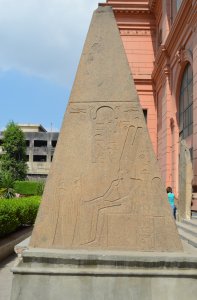
East Side August 4, 2014 |
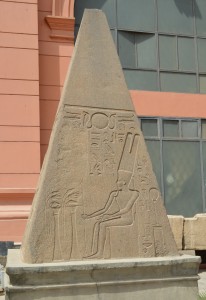
South Side April 26, 2016 |
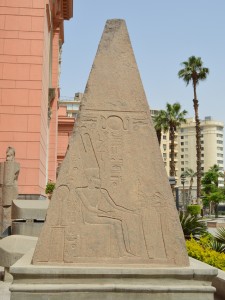
West Side April 26, 2016 |
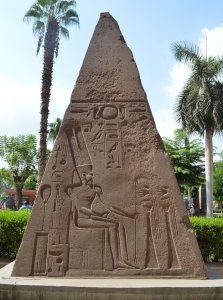
North Side August 4, 2014 |
|||
by Hiroyuki Nagase (For high definition image, please click the picture) | ||||||
2. Obelisk of Ramses II (A) (The upper portion of the obelisk)
We can understand this is an obelisk by Ramses II (Reigned 1278-1212 BC) according to the inscription. However, the details is unknown because no explanation by the museum. Only the pyramidion (most top toption) and until the middle (upper portion) of the horus name of Ramses II remain, but it's 2.6 meters high. Hence, it's estimated the obelisk was originally more than 10 meters. I assume this would be a fragment of the pair of obelisk which is currently standing in Messalla Garden, Gezira Island, 13.5 meters high, where is far only about 600 metere from this museum. Because the illustrated designs of both pyramidion are quite similar. Considering the symmetric rule of the obelisk inscription, it's not contradictory both obelisks had been standing as a pair. In this case, the obelisk (in this museum) was standing at the right side toward the temple, and the current northern side was the front. And the obelisk of Gezira Island was at the left side and the northern side was the front. If so, this obelisk (currently only the upper portion) is the one transporded from Tanis Ruins in San el-Hagar of Nile Delta.
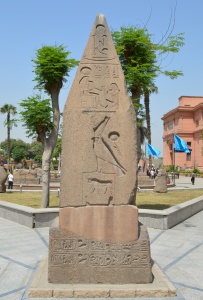 East Side May 4, 2017 |
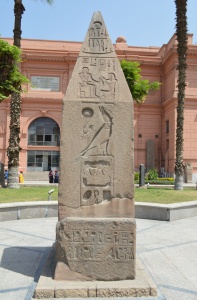 South Side May 4, 2017 |
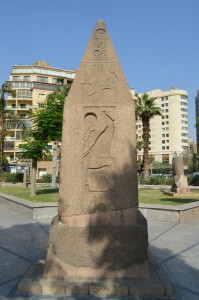 West Side April 28, 2016 |
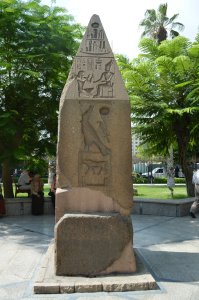 North Side August 4, 2014 |
|||
by Hiroyuki Nagase (For high definition image, please click the picture) | ||||||
3. Obelisk of Ramses II (B) (The upper portion of the obelisk)
We can understand this is an obelisk by Ramses II (Reigned 1278-1212 BC) according to the cartouche of the birth name at pyramidion. The inscription is in two lines on each side; horus name, coronation name and birth name are inscribed.
Uniqueness: Only the cartouche of the birth name at pyramidion, and only the west side inscription of two lines is bilaterally symmetrical in the outward direction, are unique of this obelisk. But, on other sides, the inscriptions face toward same direction.
Comparison and Original site: In Tanis Ruins, the fragment of the obelisk which has two line inscription (See Obelisk Figure 37 of Tanis), however this is not a pair, because two line inscription of this Tanis obelisk is toward same direction.
However, I found this obelisk was identified as "plan 241" in the Flinders Petrie's book "TANIS Part 1, 1883-4". Therefore, this obelisk (in the Egyptian Museum) was initially in Tanis.
Size: The length of this obelisk (only the upper portion) is about 1.7 meters high. Considering the width of the shaft, the original length would be 4 to 5 meters.
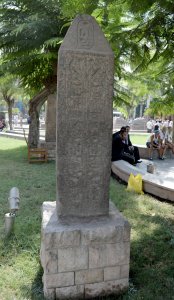 West Side August 4, 2014 |
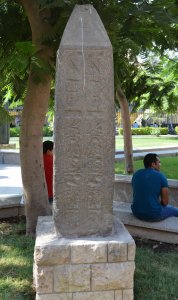 North Side August 4, 2014 |
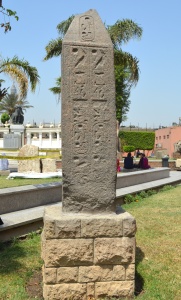 East Side May 4, 2017 |
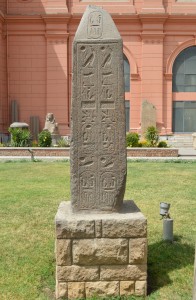 South Side April 26, 2016 |
|||
by Hiroyuki Nagase (For high definition image, please click the picture) | ||||||
4. Obelisk of Ramses II (C) (The upper portion of the obelisk)
We can understand this is also an obelisk by Ramses II (Reigned 1278-1212 BC) according to the cartouche of the birth name at pyramidion. However, the details is also unknown as well.
Uniqueness: The inscription of this obelisk is also unique. In the pyramidion on the south side, the two horuses in a red crown are facing each other, instead no horus name is inscribed. On other sides (north, east and west), the horus name, coronation name and the birth name are inscribed. The inscriptions on south amd north sides, two-line inscription is outward and bilaterally symmetric.
Comparison and Original site: The atmosphere of sculpture of the west side of this obelisk (C) and the south side of above mentioned (B) are similar impression, although the inscription synthesis are different. I found this obelisk was identified as "plan 261" in the Flinders Petrie's book "TANIS Part 1, 1883-4". Therefore, this obelisk (C) was initially in Tanis.
Size: The length of this obelisk (only the upper portion) is 2.73 meters. Considering the width of the shaft, the original length would be 4 to 5 meters.
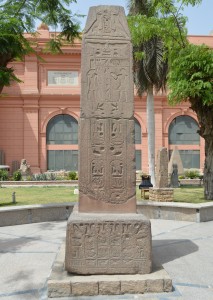 South side April 26, 2016 |
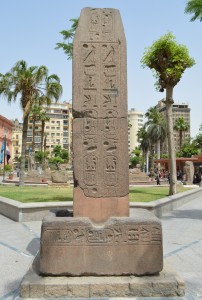 West side April 26, 2016 |
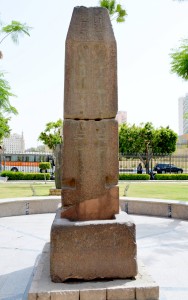 North side April 26, 2016 |
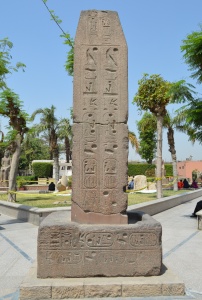 East side May 4, 2017 |
|||
by Hiroyuki Nagase (For high definition image, please click the picture) | ||||||
5. Obelisk of Ramses IV (The upper portion of the obelisk)
Importance: This is the only one existing obelisk of Ramses IV, the 20th Dynasty, Reigned 1151-1145 BC. In the book "Cleopatra's Needles and Other Egyptian Obelisks" by Wallis Budge, this obelisk with its inscriptions are introduced as one of existing important obelisks.
Size: It's 1.56 meters high. This is placed on the concrete-made foundation.
Provenance: According to the book above, this obelisk was discovered in 1887 from the building while this has been used as a building material, and was acquired by the Egyptian Museum in the same year. This is before the Museum was officially opened at the present location in 1902. Considering such history, this would be the earliest one among the collections of the Egyptian Museum.
Inscription: All the inscriptions on each side are different. However, the position of cartouche of the coronation name of Ramses IV at the top of the fragment, and the cartouche of the birth name at the lower portion, are all in place. We should understand that the symmetry and style beauty were fully considered. The vestige of colored white on the hieroglyphic inscription is seen on the west side only.
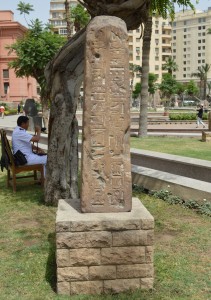 West side April 26, 2016 |
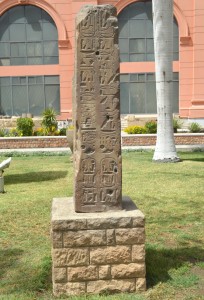 South side April 26, 2016 |
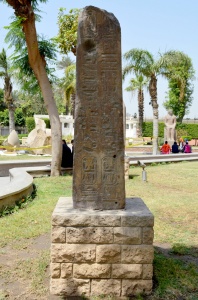 East side May 4, 2017 |
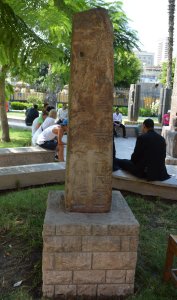 North side August 4, 2014 |
|||
by Hiroyuki Nagase (For high definition image, please click the picture) | ||||||
6. Obelisk of Tuthmosis III (A portion)
According to the horus name, coronation name, and the birth name on the inscription, this was made by Tuthmosis III (Reigned 1504-1450 BC). However, it's uncertain whether or not this is a real obelisk. A certain book in Britain says, this may be a kind of stone monument. The shape is getting slightly thinner at the upper side, so it is a shape of obelisk, but I can not determine. If this is a part of obelisk, this would be the lowest portion.
Size & Inscription: It's 3.7 meters high. The inscription is on the only one side (south side), and all other sides are left blank.
The back behind of the obelisk on the east side picture below is a headquarters building of NDP (National Democratic Party) which was set fire at the 2011 revolution. When I revisited here in 2016, the building was being demolished.
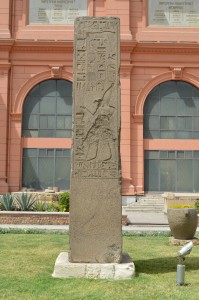 South side April 26, 2016 |
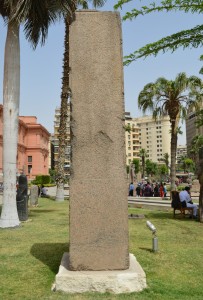 West side April 26, 2016 |
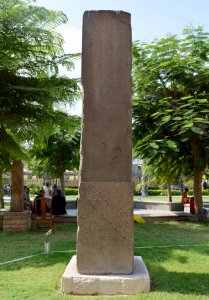 North side August 4, 2014 |
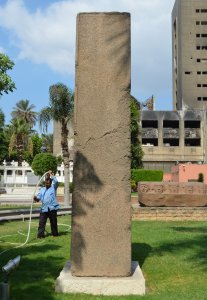 East side August 4, 2014 |
|||
by Hiroyuki Nagase (For high definition image, please click the picture) | ||||||
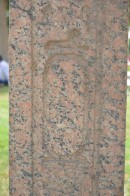 Cartouche
Cartouchewothout name |
7. Obelisk which the Pharaoh's Name was Removed (A portion)
Size: It's about 1.5 meters high.
Secret of Inscription: This obelisk, only the east side has an inscription. The inscription is interrupted at the upper and the lower sides, therefore both top and the bottom portiions of this obelisk were missing. The right picture shows the cartouche at the lower end. It looks the pharaoh's name was removed or erased. However, it looks that the vestige is too beautiful, and less pit, so there is a possibility that the cartouche was not engraved when this obelisk was made. It's hardly understand why and who made an obelisk without the pharaoh's name or cartouche. This would not be an unfinished obelisk.
It's well known story that Ramses II erased the pharaoh's name of old obelisk and change to his own name. But, there are not many pharaohs who have been treated such that the pharaoh's name was erased - say, Akhenaten who abandoned the traditional Egyptian polytheism, and Queen Hatshepsut, who was neglected after her death and attempted to remove Hatshepsut's name from historical and pharaonic records. However, the describe style of the inscription looks like at the late period dynasty or Ptolemaic dynasty, rather tha such old style. In Ptolemaic dynasty, there were many benighted kings, and there are also many kings who were banished by the civilian revolts, so this obelisk may be the one of such a king.
In the database of the collections of Egyptian Museum, there were two such things. One is "Obelisk Ptolemaic(?)"(CG 17034, JE 55313) that the pharaoh's name was not described. If this is the one, this seems to be unearthed in the island of Elephantine near Aswan. Another one is "Upper part of obelisk, name lost (430) CG 17037(17010 bis), JE 53834)". It says "name lost". This one seems to be unearthed in Serabit el-Khadim of Sinai Peninsula.
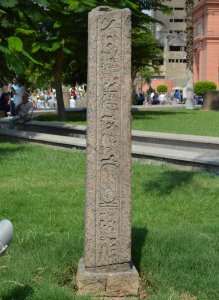 East side |
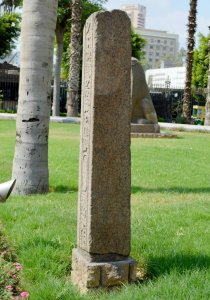 North side |
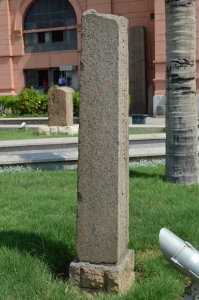 South side |
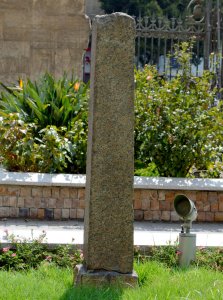 West side |
|||
August 4, 2014 by Hiroyuki Nagase (For high definition image, please click the picture) | ||||||
8. Obelisk of Nectanebo II (A lower portion)
Location: There are two obelisks in the Museum. This is the one of two, which is placed in the room for the antiquities of Third Intermediate Period and Ptolemaic dynasty.
Size & Stone: It's about 1.8 meters high. Red granite.
The inscription starts at the middle of the coronation name. Hence, we understand the upper portion is missing. Although the inscription on the lower side is considerably deteriorated, since the frame line surrounding the inscription is visible in the front, it seems that the bottom part of this obelisk is not lost. On the inscription, the coronation name and the birth name of Nectanebo II (Late Period, The 30th Dynasty, 4 Century BC) can be read. Speaking of Nektanevo II, I recall the black pair Obelisks of the British Museum. However, the hieroglyph of the Obelisks of the British Museum is engraved neatly, and for this obelisk, I feel the carving is shallow and poor.
In the collection list, "Lower part of obelisk of Nektanebos II, red granaite" (CG 17031, JE-26414) is listed. If this is the one, this obelisk was discovered in the Tell Basta Ruins, about 80 km north of Cairo.
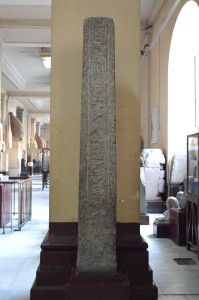 Front side |
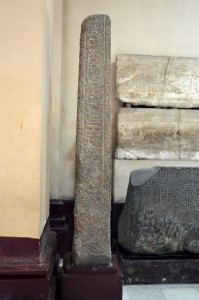 Left side |
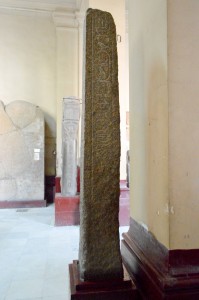 Right side |
||
April 26, 2016 by Hiroyuki Nagase (For high definition image, please click the picture) | ||||
9. Obelisk of Ahmose II (Amasis) (A lower portion)
Location: This is also placed in the above mentioned room for the antiquities of Third Intermediate Period and Ptolemaic dynasty.
Size & Stone: It's about 1.3 meters high. Red granite.
The inscription starts at the last part of the horus name. Hence, we understand the upper portion is missing. The coronation name and the birth name cab be read, and since the frame line surrounding the inscription is visible at bottom, it seems that the bottom part of this obelisk is not lost. The coronation name and the birth name of Ahmose II (Amasis) (Late Period, The 26th Dynasty, 6 Century BC) can be read.
In the collection list, "Lower part red granite obelisk of Amasis" (CG 17029, JE 44264) is described. According to this, this obelisk was discovered in the Ptolemais Hermou Ruins, about 100 km northeast of Luxor.
Because of this obelisk is placed at the corner of the wall, I could take a picture of the front side, and the right side was from only diagonally front, but couldn't take other two sides. The inscription on the right side is more clearly seen.
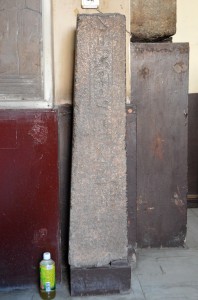 Front side |
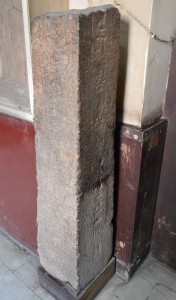 Right side |
|
April 26, 2016 by Hiroyuki Nagase (For high definition image, please click the picture) | ||
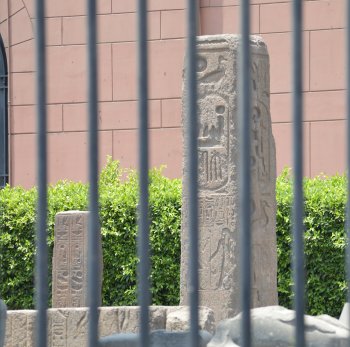 10. Obelisk of Ramses II (Two portions)
10. Obelisk of Ramses II (Two portions)
The eastern side of the Museum is a walkway of the staff, and many stone statues without the neck and/or stones like the obelisk's pedestal are placed there. I wanted to confirm the stones like the obelisk or a stone pillar, as I saw them from the distance. But I couldn't approach this site as the security soldier did not allow me. Also I tried to reach there from the east outside of the Museum, but I couldn't approach due to the barricade. The right picture is the one which I took through the fence bars. As far as I see the picture, I understand the name of Ramses II is inscribed, on each stone. But I'm not sure whether obelisk or other stone material like a pillar. (April 26, 2016 by Hiroyuki Nagase)
Notes For Pictures:
I was long-time seeking the reason why the obelisks in the garden of Egyptian Museum are ignored despite of the obelisk in the Luxor Museum are always referred on many websites. But I was finally realized when I was resting in the shade of the garden of the museum and seeing the tourists. Most tourists, especially group tourists, will not see the stone statues and stone monuments in the garden and go directly into the museum. The obelisk of the Luxor museum is on the visitors' course, but the obelisks (and other antiquities) here are not noticed because it is out on the visitors' course. This difference leads to this result. This would not a result of intension, but just an ignorance of website's authors, I assume.
Copyright Hiroyuki Nagase nagase@obelisks.org and Shoji Okamoto okamoto@obelisks.org